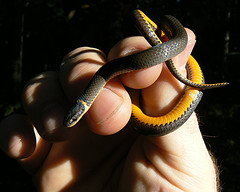From your description this very much sounds like a ringneck snake or ring-necked snake. It is found throughout much of the United States, central Mexico, and south eastern Canada..
Ring-necked snakes are secretive and very nocturnal and are rarely seen during the day time. They are slightly venomous but their non-aggressive nature and small rear-facing fangs pose little threat to humans who wish to handle them. They are best known for their unique defense posture of curling up their tails exposing their bright red-orange posterior, ventral surface when threatened.
Ring-necked snakes are believed to be fairly abundant throughout most of their range though no scientific evaluation supports this theory. Scientific research is lacking for the ring-necked snake and more in-depth investigations are greatly needed.
Ring-necked snakes occur in a wide variety of habitats. Preference seems to be determined by areas with abundant cover and denning locations spaces Northern and western species are found within open woodlands near rocky hillsides, or in wetter environments with abundant cover or woody debris. Southern species exist primarily within riparian and wet environments, especially in more arid habitats. Stebbins (2003) identified the species as a snake of moist habitats, identifying that moist soil conditions were the preferred substrate. Ring-necked snakes are also not found above an elevation of 2200 meters. In northern regions, dens are also important in identifying suitable ring-necked snake habitat.
Dens are usually shared communally and are identifiable by an existent subsurface crevasse or hole that is deep enough to prevent freezing temperatures. Since it is a woodland reptile, it can commonly also be found under wood or scraps. Because of the hot weather, they tend to make holes and burrow or they decide to hide under rocks or any suitable material. They are normally found in flatland forests.
Ring-necked snakes are secretive and very nocturnal and are rarely seen during the day time. They are slightly venomous but their non-aggressive nature and small rear-facing fangs pose little threat to humans who wish to handle them. They are best known for their unique defense posture of curling up their tails exposing their bright red-orange posterior, ventral surface when threatened.
Ring-necked snakes are believed to be fairly abundant throughout most of their range though no scientific evaluation supports this theory. Scientific research is lacking for the ring-necked snake and more in-depth investigations are greatly needed.
Ring-necked snakes occur in a wide variety of habitats. Preference seems to be determined by areas with abundant cover and denning locations spaces Northern and western species are found within open woodlands near rocky hillsides, or in wetter environments with abundant cover or woody debris. Southern species exist primarily within riparian and wet environments, especially in more arid habitats. Stebbins (2003) identified the species as a snake of moist habitats, identifying that moist soil conditions were the preferred substrate. Ring-necked snakes are also not found above an elevation of 2200 meters. In northern regions, dens are also important in identifying suitable ring-necked snake habitat.
Dens are usually shared communally and are identifiable by an existent subsurface crevasse or hole that is deep enough to prevent freezing temperatures. Since it is a woodland reptile, it can commonly also be found under wood or scraps. Because of the hot weather, they tend to make holes and burrow or they decide to hide under rocks or any suitable material. They are normally found in flatland forests.


